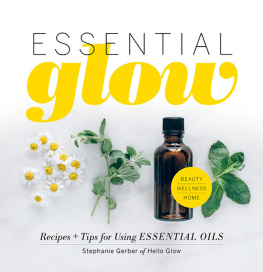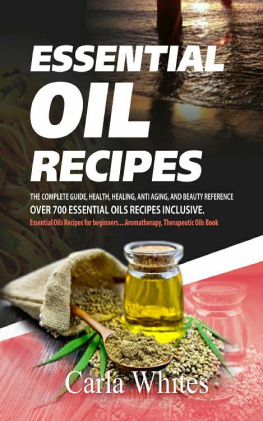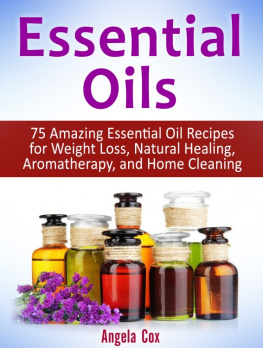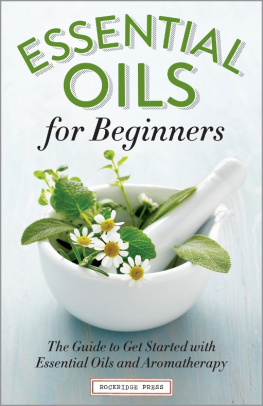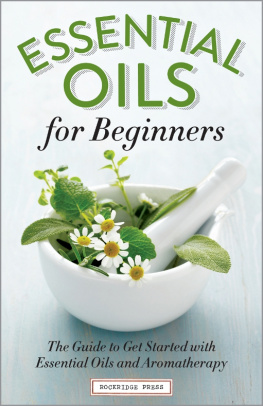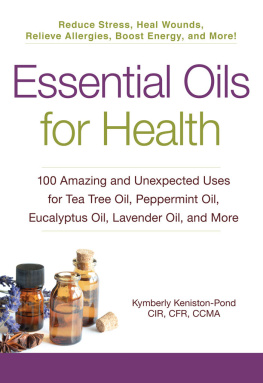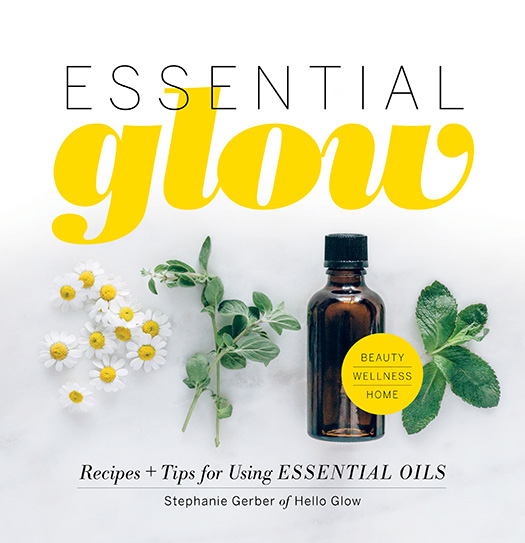
Stephanie Gerber
of Hello Glow


Introduction
Like a lot of people, lavender was my first essential oil. It seemed like a good place to startit smells amazing and has a million uses, give or take a few! Next I tried peppermint and eucalyptus, then lemon and tea tree, and now Im a little afraid to know how many essential oils are in my collection. But those first five created a solid foundation for tons of first-aid recipes, skincare concoctions, and homemade green-cleaning formulas.
Before I started learning about essential oils therapeutic uses, I was drawn to their pleasing aromas. The exotic scents of ylang ylang and jasmine. The clean, woodsy notes of juniper and pine, which make me think of long walks in the crisp fall air. The bright, uplifting fragrances of grapefruit, lime, and sweet orange. Your sense of smell is powerful, so start by using your own nose to select the essential oils that improve your moodthat make you feel fresh, delicate, sexy, you name it!
But know that the applications for essential oils go so much farther than mere perfume. Using these distillations in a holistic program for your body and spirit is at the heart of aromatherapy, and this book is designed to help you incorporate these helpful elixirs into your daily life. Ive broken down the benefits of more than 20 of the most popular essential oils, and for each offered easy, effective recipes for wellness, beauty, and home that help you get the most of their individual powers and properties. (Psst: Many recipes call for a few essential oilsso youll get to explore more than 40 totalbut the featured oil is always the most prominent in the blend.)
The active compounds in essential oils can help majorly expand your wellness repertoirefrom helping your body heal minor scrapes and cuts to kicking a headache, acne, or PMS. Theyll also help you create a cooling spray to relieve sunburn, give yourself a massage to ease achy muscles after a workout, or apply a hydrating mask to dull and dry skin.
As you explore essential oils, aromatherapy will become a key part of the self-care rituals that contribute to your overall health. You can support your sleep by spritzing a calming room spray or drawing an aromatic bath. Craft DIY cleaners to reduce the toxin load in your home, or enhance a stress-reducing meditation or yoga practice with grounding essential oils.
Ive also covered the basic usage guidelinesthese oils can be potent, so selecting, diluting, and storing them properly is crucial to a safe and positive experience. Plus, some arent recommended for people of certain ages or with specific medical concerns; to reap the benefits, youve got to heed this advice!
But theres also plenty of fun advice in this books pages. Youll soon find yourself playing mixologist, concocting new favorite fragrances and blends that target all kinds of everyday wants and desires (from making your home smell zesty fresh to freshening up your love life). Theres also a quick-look guide to selecting the best essential oils for lifes minor trials and tribulations.
Clean living and conscientious beauty rituals mean caring about the ingredients you use in your house and on your skin. My goal is to give you practical, enjoyable ways to care for yourself, your family, and your home. And, of course, to make everything smell absolutely amazing!


Essential Oils 101
The popularity of essential oils has skyrocketed in recent years as people have increasingly looked for natural ways to take control of their well-being. But these helpful elixirs can be overwhelmingwith so many to choose from, which ones do you really need? Take a deep breath: Im going to explain what these powerful oils are all about, as well as how to select, use, and store them.
What are essential oils?
An essential oil is a highly concentrated plant extract that contains active chemical compounds, the most common of which are hydrocarbons in the form of terpenes. These compounds team up to give a plant a particular aroma, which plants produce to attract pollinators, defend against insects or other plants, or protect from bacterial or fungal attacks. These chemical agents also lend essential oils their antiseptic, anti-inflammatory, and antiviral propertiesthats right, they do more than just smell good!
Unlike cooking oils, essential oils feel light and nongreasy. Theyre also highly volatile, meaning that they quickly turn to vapor and evaporate when heated. They dissolve in other oils, alcohols, honey, and milk (but not in water).
Essential oils may be extracted from flowers, leaves, seeds, or berries. Rose essential oil, for example, comes from petals (it takes 1,000 to make one tiny bottle!), while citrus essential oils are drawn from the peel and eucalyptus essential oil originates in the leaf. The most common method of extracting this so-called essence is distillation, the process by which plants inside a high-pressure still are subjected to steam or water, which softens the organic matter so that the oils can be extracted and separated from the water. Another common process is cold-press, or expression: The organic matter undergoes extreme pressure and rotation, which batters it and makes it release oil. Oils from fragile plants like jasmine, gardenia, rose, and neroli are sometimes extracted using a solvent, which creates an absolute.
What are their benefits?
The way to health is to have an aromatic bath and scented massage every day, said Hippocrates, the Greek physician considered the founding father of natural medicine. And, 2,500 years later, who can argue with that?
Essential oils generally work in two ways. First, they have powerful aromas. When we inhale one of their scents, it sends messages to our brains olfactory bulbs, affecting emotions and the limbic system (the part of the brain that controls memory), as well as breathing, blood circulation, and hormones. Second, essential oils small molecular structures allow them to penetrate the skin more easily than other vegetable or nut oils, which stay on the skins surface; this trait makes essential oils ideal for topical application. The tiny molecules work their way into the bloodstream and lymphatic system, treating aches and pains or repairing scars and skin tissue. (Essential oils are too concentrated to be applied directly to the skin, however, and must be diluted in a carrier oil or liquid; for more information.)
How do you use essential oils?
Essential oils are helpful in a myriad of applications. Here are a few common ways to add them to your daily routine.
DIFFUSION A reed diffuser, room spray, or steam vaporizer allows you to fill your environment with the aromas of essential oils. You can buy a diffuserseveral stylish models are readily available from major retailers and onlineor fashion your own ().
INHALATION There are several ways to breathe in the benefits! Apply 1 or 2 drops to a handkerchief, carry it in your pocket, and pull it out to inhale the aroma, reviving your energy or resetting your mood whenever you like. You can also sprinkle a few drops on your pillow at night. For an effective steam treatment, add 1 or 2 drops to a bowl filled with 3 cups (710 mL) boiling water. Place a towel over your head and the bowl, and breathe deeply for no more than 10 minutes. (Get the OK from your doctor before using any essential oil if you have asthma or other respiratory issues.)

